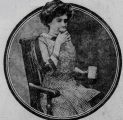Images are wonderful and mysterious things. Close your eyes and imagine an apple.
Can you “see” it? Do you have a small picture of it in front of you that you can see? If so, can you count the blemishes on it?
Some people, in other words, can close their eyes and have a vivid image or picture of whatever they want to see. Some people have shifting or partial images, and some do not seem to have this ability at all. Science does not know much about images and how they work, but we know we are capable of creating practically any reality we want by letting our imaginations roam free.The Centering Book: Awareness Activities for Children and Adults to Relax the Body and Mind
by Gay Hendricks; Russel Wills
1992
The explanation lies mainly in his inability to visualise. He did not number the streaks of the tulip because, in effect, he did not see them; but he remarked general properties and large appearances because he had the gift, which he assiduously developed, of viewing things in their moral aspects and human relationships.
The Cambridge History of English Literature
(about Samuel Johnson and Rasselas)
1907
Memorizing the words of the book used to be defended in school on the ground that it “trains the memory.” It does train the verbal memory, but not the memory, for color, sound, etc.
What we commonly call “varieties of memory,” as found in different persons, are really so many different memories.
(…)
I say ‘imaginations,” for as we have not “a memory,” but “memories,” so we have not “an imagination,” but imaginations.Springfield weekly Republican, 1893
